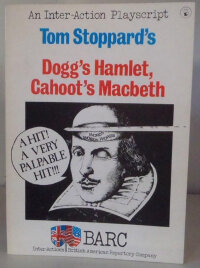Tom Stoppard
In Tom Stoppard Plays: I
London: Faber and Faber, 1996
The two short pieces that eventually became Dogg’s Hamlet were first presented in 1971. They bring together an enactment of a philosophical scenario envisioned by Wittgenstein about the mutual intelligibility of language, as well as a radically condensed “15-Minute Hamlet” performance. Shakespeare appears as a character when the first section of the play transitions to the second. He appears in the role of prologue to the Hamlet production, and proceeds to speak several lines, jumbled together, from the play, including “Something is rotten in the state of Denmark” and “To be or not to be.” The lines don’t cohere into anything but a tapas-like selection of Shakespearean appetizers. Shakespeare can describe his own work only by reference to itself, and yet his “chorus” still feels uncannily lucid. That this speechis not intelligible in itself, but still has unmistakable aesthetic power, is both a testament to the familiarity and cultural weight of Hamlet, if even in its fragments, and to Shakespeare’s line-by-line poetic craftsmanship, as well as a reflection on Stoppard/Wittengenstein’s investigation into language as a tool for creating communion as well as alienation. Dogg’s Hamlet is often presented (as it is in the Faber and Faber edition of Stoppard’s plays) alongside a companion piece, Cahoot’s Macbeth, a play that derives from Stoppard’s involvement with the Charter ’77 movement, and which deals explicitly with the fate of theater under totalitarianism. But while Shakespeare is discussed in this play, only in Dogg’s Hamlet does Shakespeare appear as a character. –BW
